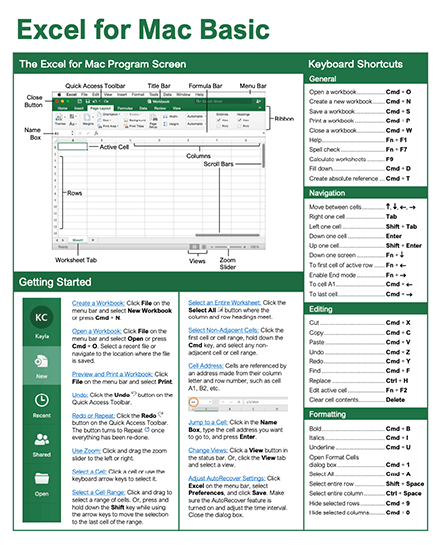

Returns TRUE if A2 contains "Bananas", B2 is greater than or equal to 30 and B2 is greater than C2, FALSE otherwise.īy itself, the Excel AND function is not very exciting and has narrow usefulness. Returns TRUE if B2 is greater than 20 and B2 is equal to C2, FALSE otherwise. Returns TRUE if A2 contains "Bananas" and B2 is greater than C2, FALSE otherwise.
Beginner excel tutorial 2016 pdf how to#
The first condition (logical1) is required, subsequent conditions are optional.Īnd now, let's look at some formula examples that demonstrate how to use the AND functions in Excel formulas. Where logical is the condition you want to test that can evaluate to either TRUE or FALSE. The syntax for the Excel AND function is as follows: Technically, the AND function tests the conditions you specify and returns TRUE if all of the conditions evaluate to TRUE, FALSE otherwise. It comes in handy when you have to test several conditions and make sure that all of them are met. The AND function is the most popular member of the logic functions family. In Excel 2003 and lower, you can supply up to 30 arguments and the total length of your formula shall not exceed 1,024 characters. In Excel 2016, 2013, 20, you can include up to 255 arguments in a logical function, provided that the total length of the formula does not exceed 8,192 characters.For example, the XOR function can be used in Excel 20 only. A logical function returns the #NAME? error if you've misspell the function's name or attempted to use the function in an earlier Excel version that does not support it.A logical function returns the #VALUE! error if none of the arguments evaluate to logical values.For example, if cells A1:A5 contain numbers, the formula =AND(A1:A5) will return TRUE if none of the cells contains 0, FALSE otherwise. If an argument of a logical function contains numbers, then zero evaluates to FALSE, and all other numbers including negative numbers evaluate to TRUE.If all of the arguments are empty cells, the formula returns #VALUE! error. If an argument of a logical function contains any empty cells, such values are ignored.However, all arguments must evaluate to the Boolean values of TRUE or FALSE, or references or arrays containing logical values. In arguments of the logical functions, you can use cell references, numeric and text values, Boolean values, comparison operators, and other Excel functions.Excel logical functions - facts and figures In additions to the four logical functions outlined above, Microsoft Excel provides 3 "conditional" functions - IF, IFERROR and IFNA. The formula returns FALSE if a value in cell A1 is greater than or equal to 10 TRUE otherwise. Returns TRUE if all of the arguments evaluate to TRUE. The following table provides a short summary of what each logical function does to help you choose the right formula for a specific task. As well as logical operators, Excel logical functions return either TRUE or FALSE when their arguments are evaluated. You use these functions when you want to carry out more than one comparison in your formula or test multiple conditions instead of just one. Microsoft Excel provides 4 logical functions to work with the logical values. Excel logical functions such as AND, OR, XOR and NOT will help you in doing this. Today, you will see how to extend the use of logical operators and construct more elaborate tests to perform more complex calculations. Last week we tapped into the insight of Excel logical operators that are used to compare data in different cells. The tutorial explains the essence of Excel logical functions AND, OR, XOR and NOT and provides formula examples that demonstrate their common and inventive uses.


 0 kommentar(er)
0 kommentar(er)
